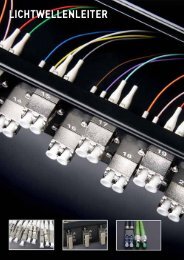Fiber Optics Test Equipment Catalog
Fiber Optics Test Equipment Catalog
Fiber Optics Test Equipment Catalog
You also want an ePaper? Increase the reach of your titles
YUMPU automatically turns print PDFs into web optimized ePapers that Google loves.
Advantages of Using a <strong>Fiber</strong> Optic Certification <strong>Test</strong> Kit<br />
<strong>Test</strong> kits containing a certification-ready optical power meter and fiber optic light source are the best option for fiber network certification, preferably<br />
ones that come pre-configured with fiber cabling standard loss parameters. These kits ensure that the network meets the end-to-end loss<br />
requirements based on industry-accepted cabling standards. And as bandwidth requirements increase, link budgets become tighter, requiring<br />
greater accuracy from fiber optic loss testing equipment.<br />
Invariably, someone will ask about certifying a fiber network with an optical time domain reflectometer, or OTDR. OTDRs are excellent pieces of<br />
equipment and are a vital part of any fiber optic professional’s test arsenal. OTDRs are good at getting a snapshot of the fiber link and determining<br />
where a problem is, but are not a viable option for network certification since they are inherently inaccurate in measuring optical power.<br />
Certification test sets also offer a distinct advantage over standard optical loss kits and bit-error rate (BERT) testers. Here is an analogy to help<br />
demonstrate this advantage: suppose you need to cross a frozen lake, and can see that it is frozen, but are unsure if the ice is thick enough to support<br />
your weight, or better yet, the maximum weight it can support. Thus, you need to test the ice to make sure you can cross. Likewise, a fiber can pass<br />
light but until the fiber is certification tested, you cannot be sure if the amount of light will be enough to support your current bandwidth requirements.<br />
Is your network operating with sufficient overhead, or are some of your fiber links operating right on the line of your PASS/FAIL threshold, ready to<br />
suffer intermittent failures with the slightest change in environment (i.e. temperature, humidity, or mechanical vibration) Also, will the fiber support<br />
the future bandwidth requirements of next generation fiber networks Can your current link power budget be resilient enough to handle an upgrade<br />
to gigabit standards The only way to know for sure is by using quality certification test sets such as the OWL series of certifying fiber optic test<br />
equipment.<br />
Optical certification is widely accepted as the proper way to test a fiber network, and is required by industry and governments worldwide. No<br />
reputable fiber optic cable installer goes without a certifying power meter for reasons including:<br />
Network cable warranties - Almost every extended fiber optic cable warranty requires a certification report be sent to the cable manufacturer to<br />
qualify for long term warranty approval;<br />
Network installation bids - Bids more often than not require the installer to submit certification reports, especially when working with government<br />
institutions;<br />
Arbitration resolution - Certification reports can be used as proof of quality work in case a dispute arises between installer and customer, such as<br />
determining whether the problem is related to the active network equipment or the fiber optic installation.<br />
With NIST-traceable OWL certification test kits and proper industry test procedures, you and your customers can rest assured that you have installed<br />
a quality fiber optic network.<br />
Questions<br />
Phone: 262-473-0643<br />
23<br />
owl-inc.com









